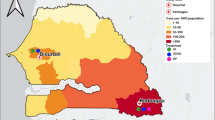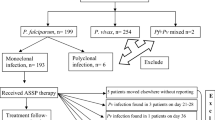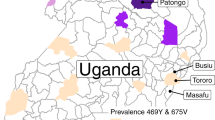Abstract
We investigated the influence of efavirenz (EFV)- or nevirapine (NVP)-based antiretroviral therapy (ART) on lumefantrine plasma exposure in HIV-malaria-coinfected patients and implication of pharmacogenetic variations. A total of 269 HIV patients with uncomplicated falciparum malaria on NVP-based ART (NVP-arm), EFV-based ART (EFV-arm) or not receiving ART (control-arm) were enrolled and treated with artemether-lumefantrine. Day-7 lumefantrine, baseline EFV and NVP plasma concentrations, and CYP2B6*6,*18, CYP3A4*1B, CYP3A5*3,*6,*7, ABCB1 c.3435C>T and ABCB1 c.4036A>G genotypes were determined. The median day-7 lumefantrine plasma concentration was significantly lower in the EFV-arm compared with that in NVP- and control-arm. High EFV plasma concentrations and CYP2B6*6/*6 genotype significantly correlated with low lumefantrine plasma concentrations and high rate of recurrent parasitemia. No significant effect of NVP-based ART on lumefantrine exposure was observed. In conclusion, owing to long-term CYP3A induction, EFV-based ART cotreatment significantly reduces lumefantrine plasma exposure leading to poor malaria treatment response, which is more pronounced in CYP2B6 slow metabolizers.
This is a preview of subscription content, access via your institution
Access options
Subscribe to this journal
Receive 6 print issues and online access
$259.00 per year
only $43.17 per issue
Buy this article
- Purchase on Springer Link
- Instant access to full article PDF
Prices may be subject to local taxes which are calculated during checkout




Similar content being viewed by others
References
Mwenesano DR . Prevalence of HIV and malaria co-infection among HIV AND AIDS patients admitted to Medical Wards at Amana Municipal Hospital, Ilala District, Dar es Salaam. Muhimbili University of Health and Allied Sciences 2010. Available at: http://ir.muhas.ac.tz:8080/jspui/handle/123456789/1177 (last accessed 8 February 2015).
Tanzania Commission for AIDS (TACAIDS). Tanzania HIV/AIDS and malaria indicator survey 2011-2012 (THMIS III). Available at: http://www.tacaids.go.tz/index.php?option=com_content&view=article&id=139:current-status-of-hiv-and-aids&catid=31:hiv-and-aids-information-&Itemid=159 (last accessed 8 February 2015).
Berg A, Patel S, Aukrust P, David C, Gonca M, Berg ES et al. Increased severity and mortality in adults co-infected with malaria and HIV in Maputo, Mozambique: a prospective cross-sectional study. PLoS One 2014; 9: e88257.
Alemu A, Shiferaw Y, Addis Z, Mathewos B, Birhan W . Effect of malaria on HIV/AIDS transmission and progression. Parasit Vectors 2013; 6: 18.
Trott KA, Chau JY, Hudgens MG, Fine J, Mfalila CK, Tarara RP et al. Evidence for an increased risk of transmission of simian immunodeficiency virus and malaria in a rhesus macaque coinfection model. J Virol 2011; 85: 11655–11663.
World Health Organization. Guidelines for the treatment of malaria: second edition. Available at: http://apps.who.int/medicinedocs/documents/s19105en/s19105en.pdf. Library Cataloguing-in-Publication Data 2010 (last accessed 8 February 2015).
Hastings I . How artemisinin-containing combination therapies slow the spread of antimalarial drug resistance. Trends Parasitol 2011; 27: 67–72.
Bhattarai A, Ali AS, Kachur SP, Martensson A, Abbas AK, Khatib R et al. Impact of artemisinin-based combination therapy and insecticide-treated nets on malaria burden in Zanzibar. PLoS Med 2007; 4: e309.
Baliraine FN, Rosenthal PJ . Prolonged selection of pfmdr1 polymorphisms after treatment of falciparum malaria with artemether-lumefantrine in Uganda. J Infect Dis 2011; 204: 1120–1124.
Ferreira PE, Culleton R . Dynamics of Plasmodium falciparum selection after artemether-lumefantrine treatment in Africa. J Infect Dis 2012; 205: 1473–1475.
Maganda BA, Minzi OM, Kamuhabwa AA, Ngasala B, Sasi PG . Outcome of artemether-lumefantrine treatment for uncomplicated malaria in HIV-infected adult patients on anti-retroviral therapy. Malar J 2014; 13: 205.
Lin JH, Lu AY . Inhibition and induction of cytochrome P450 and the clinical implications. Clin Pharmacokinet 1998; 35: 361–390.
Lynch T, Price A . The effect of cytochrome P450 metabolism on drug response, interactions, and adverse effects. Am Fam Physician 2007; 76: 391–396.
Panel on Antiretroviral Guidelines for Adults and Adolescents. Guidelines for the use of antiretroviral agents in HIV-1-infected adults and adolescents. Department of Health and Human Services. Available at: http://aidsinfo.nih.gov/contentfiles/lvguidelines/adultandadolescentgl.pdf (last accessed 8 February 2015).
Ward BA, Gorski JC, Jones DR, Hall SD, Flockhart DA, Desta Z . The cytochrome P450 2B6 (CYP2B6) is the main catalyst of efavirenz primary and secondary metabolism: implication for HIV/AIDS therapy and utility of efavirenz as a substrate marker of CYP2B6 catalytic activity. J Pharmacol Exp Ther 2003; 306: 287–300.
Erickson DA, Mather G, Trager WF, Levy RH, Keirns JJ . Characterization of the in vitro biotransformation of the HIV-1 reverse transcriptase inhibitor nevirapine by human hepatic cytochromes P-450. Drug Metab Dispos 1999; 27: 1488–1495.
German PI, Aweeka FT . Clinical pharmacology of artemisinin-based combination therapies. Clin Pharmacokinet 2008; 47: 91–102.
Djimde A, Lefevre G . Understanding the pharmacokinetics of Coartem. Malar J 2009; 8: S4.
Hariparsad N, Nallani SC, Sane RS, Buckley DJ, Buckley AR, Desai PB . Induction of CYP3A4 by efavirenz in primary human hepatocytes: comparison with rifampin and phenobarbital. J Clin Pharmacol 2004; 44: 1273–1281.
Weiss J, Herzog M, Konig S, Storch CH, Ketabi-Kiyanvash N, Haefeli WE . Induction of multiple drug transporters by efavirenz. J Pharmacol Sci 2009; 109: 242–250.
Faucette SR, Zhang TC, Moore R, Sueyoshi T, Omiecinski CJ, LeCluyse EL et al. Relative activation of human pregnane X receptor versus constitutive androstane receptor defines distinct classes of CYP2B6 and CYP3A4 inducers. J Pharmacol Exp Ther 2007; 320: 72–80.
Habtewold A, Amogne W, Makonnen E, Yimer G, Nylen H, Riedel KD et al. Pharmacogenetic and pharmacokinetic aspects of CYP3A induction by efavirenz in HIV patients. Pharmacogenom J 2013; 13: 484–489.
Ngaimisi E, Mugusi S, Minzi OM, Sasi P, Riedel KD, Suda A et al. Long-term efavirenz autoinduction and its effect on plasma exposure in HIV patients. Clin Pharmacol Ther 2010; 88: 676–684.
Ngaimisi E, Mugusi S, Minzi O, Sasi P, Riedel KD, Suda A et al. Effect of rifampicin and CYP2B6 genotype on long-term efavirenz autoinduction and plasma exposure in HIV patients with or without tuberculosis. Clin Pharmacol Ther 2011; 90: 406–413.
Mukonzo JK, Nanzigu S, Waako P, Ogwal-Okeng J, Gustafson LL, Aklillu E . CYP2B6 genotype, but not rifampicin-based anti-TB cotreatments, explains variability in long-term efavirenz plasma exposure. Pharmacogenomics 2014; 15: 1423–1435.
Mukonzo JK, Okwera A, Nakasujja N, Luzze H, Sebuwufu D, Ogwal-Okeng J et al. Influence of efavirenz pharmacokinetics and pharmacogenetics on neuropsychological disorders in Ugandan HIV-positive patients with or without tuberculosis: a prospective cohort study. BMC Infect Dis 2013; 13: 261.
Mukonzo JK, Roshammar D, Waako P, Andersson M, Fukasawa T, Milani L et al. A novel polymorphism in ABCB1 gene, CYP2B6*6 and sex predict single-dose efavirenz population pharmacokinetics in Ugandans. Br J Clin Pharmacol 2009; 68: 690–699.
Ngaimisi E, Habtewold A, Minzi O, Makonnen E, Mugusi S, Amogne W et al. Importance of ethnicity, CYP2B6 and ABCB1 genotype for efavirenz pharmacokinetics and treatment outcomes: a parallel-group prospective cohort study in two sub-Saharan Africa populations. PLoS One 2013; 8: e67946.
Swart M, Ren Y, Smith P, Dandara C . ABCB1 4036A>G and 1236C>T polymorphisms affect plasma efavirenz levels in South African HIV/AIDS patients. Front Genet 2012; 3: 236.
Ngaimisi E, Minzi O, Mugusi S, Sasi P, Riedel KD, Suda A et al. Pharmacokinetic and pharmacogenomic modelling of the CYP3A activity marker 4beta-hydroxycholesterol during efavirenz treatment and efavirenz/rifampicin co-treatment. J Antimicrob Chemother 2014; 69: 3311–3319.
Kredo T, Mauff K, Van der Walt JS, Wiesner L, Maartens G, Cohen K et al. Interaction between artemether-lumefantrine and nevirapine-based antiretroviral therapy in HIV-1-infected patients. Antimicrob Agents Chemother 2011; 55: 5616–5623.
Byakika-Kibwika P, Lamorde M, Mayito J, Nabukeera L, Namakula R, Mayanja-Kizza H et al. Significant pharmacokinetic interactions between artemether/lumefantrine and efavirenz or nevirapine in HIV-infected Ugandan adults. J Antimicrob Chemother 2012; 67: 2213–2221.
Lopez-Cortes LF, Ruiz-Valderas R, Marin-Niebla A, Pascual-Carrasco R, Rodriguez-Diez M, Lucero-Munoz MJ . Therapeutic drug monitoring of efavirenz: trough levels cannot be estimated on the basis of earlier plasma determinations. J Acquir Immune Defic Syndr 2005; 39: 551–556.
Ezzet F, Mull R, Karbwang J . Population pharmacokinetics and therapeutic response of CGP 56697 (artemether+benflumetol) in malaria patients. Br J Clin Pharmacol 1998; 46: 553–561.
White NJ, van Vugt M, Ezzet F . Clinical pharmacokinetics and pharmacodynamics and pharmacodynamics of artemether-lumefantrine. Clin Pharmacokinet 1999; 37: 105–125.
World Health Organization. Methods and techniques for assessing exposure to antimalarial drugs in clinical field studies. Available at: http://www.who.int/malaria/publications/atoz/9789241502061/en/. WHO Library Cataloguing-in-Publication Data 2011 (last accessed 8 February 2015).
Minzi OM, Ngaimisi E, Shewiyo DH, P S, AI M . Interlaboratory Development and cross validation of a chromatographic method for determination of lumefantrine in human plasma-a proficient capacity assessment of bioanalytical laboratories in East Africa. J Anal Bioanal Techniques 2012; 3: 131.
Maganda B, Heudi O, Cortinovis A, Picard F, Kretz O, Minzi O . A fast and reliable reversed phase high performance liquid chromatography method for simultaneous determination of selected anti-retroviral and lumefantrine in human plasma. J Chromatogr B 2013; 919-920: 52–60.
Huang L, Parikh S, Rosenthal PJ, Lizak P, Marzan F, Dorsey G et al. Concomitant efavirenz reduces pharmacokinetic exposure to the antimalarial drug artemether-lumefantrine in healthy volunteers. J Acquir Immune Defic Syndr 2012; 61: 310–316.
Ezzet F, van Vugt M, Nosten F, Looareesuwan S, White NJ . Pharmacokinetics and pharmacodynamics of lumefantrine (benflumetol) in acute falciparum malaria. Antimicrob Agents Chemother 2000; 44: 697–704.
Hoglund RM, Byakika-Kibwika P, Lamorde M, Merry C, Ashton M, Hanpithakpong W et al. Artemether-lumefantrine coadministration with antiretrovirals; population pharmacokinetics and dosing implications. Br J Clin Pharmacol 2014; 79: 636–649.
Wahajuddin, Raju KS, Singh SP, Taneja I . Investigation of the functional role of P-glycoprotein in limiting the oral bioavailability of lumefantrine. Antimicrob Agents Chemother 2014; 58: 489–494.
Oga EF, Sekine S, Shitara Y, Horie T . Potential P-glycoprotein-mediated drug-drug interactions of antimalarial agents in Caco-2 cells. Am J Trop Med Hyg 2012; 87: 64–69.
Staehli Hodel EM, Csajka C, Ariey F, Guidi M, Kabanywanyi AM, Duong S et al. Effect of single nucleotide polymorphisms in cytochrome P450 isoenzyme and N-acetyltransferase 2 genes on the metabolism of artemisinin-based combination therapies in malaria patients from Cambodia and Tanzania. Antimicrob Agents Chemother 2013; 57: 950–958.
Mukonzo JK, Waako P, Ogwal-Okeng J, Gustafsson LL, Aklillu E . Genetic variations in ABCB1 and CYP3A5 as well as sex influence quinine disposition among Ugandans. Ther Drug Monit 2010; 32: 346–352.
Mirghani RA, Sayi J, Aklillu E, Allqvist A, Jande M, Wennerholm A et al. CYP3A5 genotype has significant effect on quinine 3-hydroxylation in Tanzanians, who have lower total CYP3A activity than a Swedish population. Pharmacogenet Genom 2006; 16: 637–645.
Faucette SR, Sueyoshi T, Smith CM, Negishi M, Lecluyse EL, Wang H . Differential regulation of hepatic CYP2B6 and CYP3A4 genes by constitutive androstane receptor but not pregnane X receptor. J Pharmacol Exp Ther 2006; 317: 1200–1209.
WHO. Consolidated guidelines on the use of antiretroviral drugs for treating and preventing HIV infection. Available at: http://apps.who.int/iris/bitstream/10665/85321/1/9789241505727_eng.pdf?ua=1, 2013 (last accessed 8 February 2015).
UNAIDS. The United Republic of Tanzania: Global AIDS response country progress report, Geneva, Switzerland. Available at: http://www.unaids.org/sites/default/files/country/documents/TZA_narrative_report_2014.pdf, 2014 (last accessed 8 February 2015).
White NJ, Pongtavornpinyo W, Maude RJ, Saralamba S, Aguas R, Stepniewska K et al. Hyperparasitaemia and low dosing are an important source of anti-malarial drug resistance. Malar J 2009; 8: 253.
Acknowledgements
We are grateful to study participants Dorisia Nanage and Lilleba Bohman for their dedicated technical assistance. This study was supported by grants from the Swedish International Development Cooperation Agency Programme (SIDA MALARIA-2010/2012, Contribution no: 7500051601).
Author information
Authors and Affiliations
Corresponding author
Ethics declarations
Competing interests
The authors declare no conflict of interest.
Rights and permissions
About this article
Cite this article
Maganda, B., Minzi, O., Ngaimisi, E. et al. CYP2B6*6 genotype and high efavirenz plasma concentration but not nevirapine are associated with low lumefantrine plasma exposure and poor treatment response in HIV-malaria-coinfected patients. Pharmacogenomics J 16, 88–95 (2016). https://doi.org/10.1038/tpj.2015.37
Received:
Revised:
Accepted:
Published:
Issue Date:
DOI: https://doi.org/10.1038/tpj.2015.37
This article is cited by
-
Effect of pharmacogenetic variations on praziquantel plasma concentration and safety outcomes among school children in Rwanda
Scientific Reports (2023)
-
Drug–Drug Interactions with Antiretroviral Drugs in Pregnant Women Living with HIV: Are They Different from Non-Pregnant Individuals?
Clinical Pharmacokinetics (2020)
-
Efficacy and safety of artemether–lumefantrine as treatment for Plasmodium falciparum uncomplicated malaria in adult patients on efavirenz-based antiretroviral therapy in Zambia: an open label non-randomized interventional trial
Malaria Journal (2019)
-
Human cytochrome P450 2B6 genetic variability in Botswana: a case of haplotype diversity and convergent phenotypes
Scientific Reports (2018)
-
The drug transporter ABCB1 c.3435C>T SNP influences artemether–lumefantrine treatment outcome
Malaria Journal (2017)



